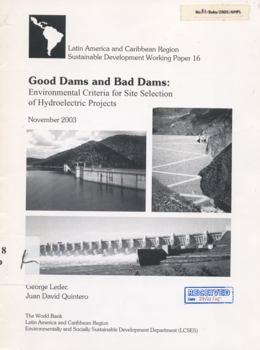Kategori Digilib
Good Dams and Bad Dams: Environmental Criteria for Site Selection of Hydroelectric Projects (Latin America and Caribbean Region Sustainable Development Working Paper 16)

George Ledec & Juan David Quintero
Environmentally and Socially Sustainable Development Department (LCSES) The World Bank, November 2003, vii + 20 hal
Th. 2003
627. 8 LED g
paper, enviroment, dams
Perpustakaan AMPL
1.283 kali
This paper provides a simple, yet robust, methodology for comparing proposed hydroelectric project sites in terms of their expected negative environmental impacts, and relating these ti power generation benefit. The paper also summarised the environmental mitigation options for large dams. If properly implemented, these mitigation measures can effectively prevent, minimize, or compensate for many (though not all) of a hydroelectric projects negative impacts. Nonetheles, the most effective environmental mitigation measure is good site selection, to ensure that the proposed dam will couse relatively little damage in the firs place.
The paper present quantitative indicators (using data that are relatively easy to obtain) for rating and ranking proposed new hydroeletric project in trems of their likely adverse environmental impacts.Project with a small reservoir survace area tend to be most desirable from both an environmental and social standpoint, in part because they minimize natural habitat losses as well as resettlement needs, In general, the most environmentally benign hydroelectric dam sites are on upper tributaries, while the most problematic ones are on the large main stems of rivers.
